At a glance
Expert’s Rating
Pros
Attractive folding OLED displayLoud, clear speakersLong battery life
Cons
Folding design is awkward for both tablet and laptop useTiny touchpadLimited connectivity, no Wi-Fi 7Performance doesn’t live up to the price
Our Verdict
The ThinkPad X1 Fold 16 is Lenovo’s latest folding experiment, but it turns out a bigger screen isn’t always better.
Folding displays are an old hat for Lenovo. Its first laptop with a folding OLED display, the Lenovo ThinkPad X1 Fold 13, arrived in 2020, and received a second generation update. The company’s new folding laptop, the ThinkPad X1 Fold 16, upgrades to a much larger OLED display. That sounds great, but reality doesn’t live up to expectations.
Looking for more laptop options? Check out PCWorld’s roundup of the best laptops available today.
Lenovo ThinkPad X1 Fold 16: Specs and features
The Lenovo ThinkPad X1 Fold 16 is an innovative device, and it all comes down to the display. It has a 16.3-inch screen with a resolution of 2,560 x 2,024 (that’s an aspect ratio of 1.26:1, which is non-standard, to say the least). It’s a flexible OLED display coated in plastic, making it possible to fold the entire device, display and all, in half. A keyboard attachment and active pen are included, too.
CPU: Intel Core i7-1250U
Memory: 16GB LPDDR5
Graphics/GPU: Intel Iris Xe integrated graphics
Display: 16.3-inch diagonal 2560×2024 folding OLED touchscreen
Storage: 512GB NVMe PCIe 4 solid state drive
Webcam: 1440p webcam with IR camera
Connectivity: 2x Thunderbolt 4, 1x USB-C 3.2 Gen 2
Networking: Wi-Fi 6E, Bluetooth 5.1, optional 5G mobile data
Biometrics: Windows Hello facial recognition, fingerprint reader
Battery capacity: 48 watt-hour + 16 watt-hour dual battery (base model has single 48 watt-hour battery)
Dimensions: 6.94 x 10.87 x 0.69 inches (folded, screen only).
Weight: 2.89 pounds (screen only) up to 4.27 pounds (with keyboard and kickstand)
MSRP: $2,499 to start, $3,246 as-tested.
Dig deeper into the specifications, however, and there’s two red flags. The first is the processor. Lenovo relies on Intel’s older 12th-gen Core processors, not the newer, more power-hungry, and more performant 13th-gen Core or Intel Core Ultra processors.
And then there’s the price. You can expect to pay at least $2,500 for the X1 Fold 16, if you buy at MSRP, and the model I reviewed rang up at $3,246. That’s a lot of scratch, and it erodes the device’s value.
Lenovo ThinkPad X1 Fold 16: Design and build quality
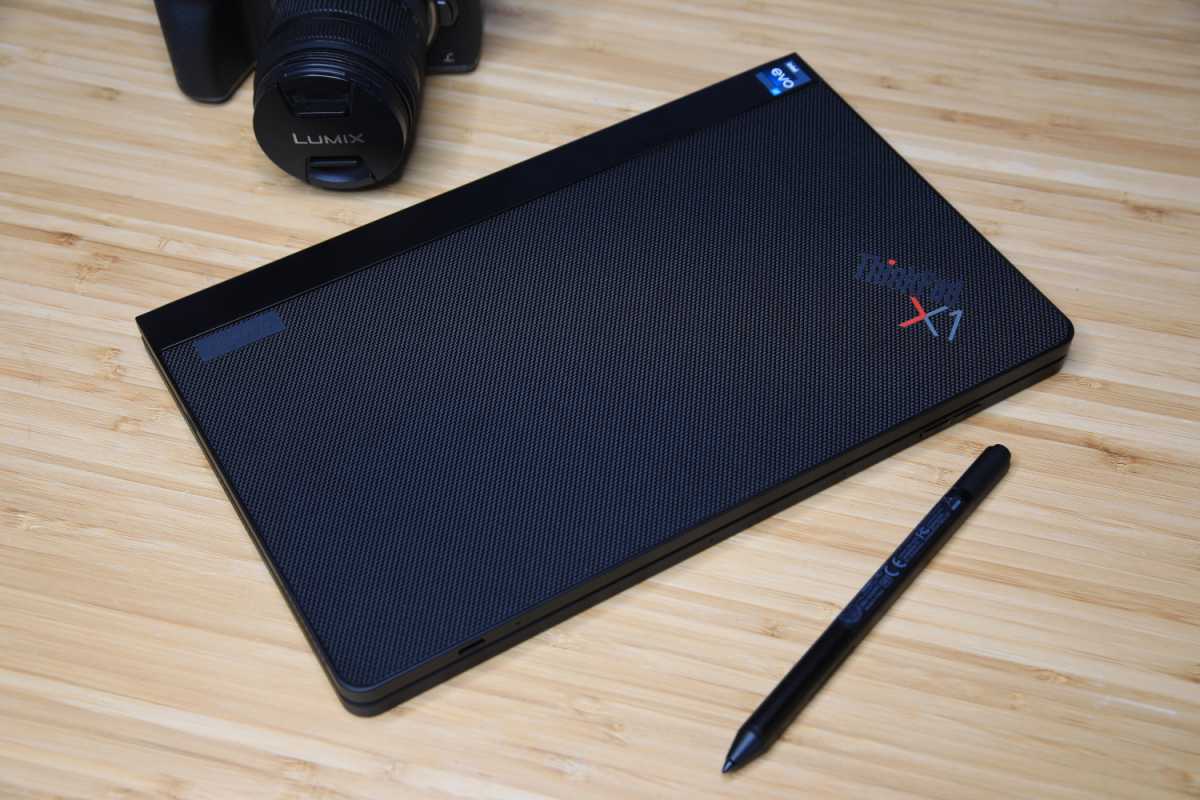
IDG / Matthew Smith
The Lenovo ThinkPad X1 Fold 16 Gen 1’s design is innovative, to say the least. It pairs a 16.3-inch OLED touchscreen with a folding mechanism that turns the display into a notebook-sized portable. The hinge has enough resistance to keep it firmly in whichever position it’s placed, but not so much that it’s difficult to use.
Because of this, it’s possible to use the X1 Fold 16 in several modes. If folded at a 90 degree angle, or something close to it, it becomes an ultra-portable laptop. The upper half the display remains the display, while the keyboard attaches magnetically to the lower half. If the display is laid flat, however, the keyboard can instead be used as a kickstand for it—a bit like a plus-sized Surface Pro.
The display can also be used without the keyboard. Folding it part-way and holding it like a book can prove useful for reading documents. Lay the display flat, however, and the X1 Fold becomes a gigantic tablet.
It all sounds good, even great, on paper. But my time with the X1 Fold 16 left me frustrated.
The large 16.3-inch display proves more awkward than it seems. Unfolding the display and using it with the keyboard’s kickstand delivers gobs of display space, which I appreciate. But the X1 Fold isn’t really a laptop in this mode, as you need a large, flat surface to keep it stable.
Folding the display and using the X1 Fold as a clamshell laptop reveals other weaknesses. The screen is small in this mode, yet the keyboard deck feels tall, which looks and feels awkward. I also noticed some apps (mostly older apps with no recent updates) didn’t want to play nice with the boundaries of the display, causing portions of the app to appear below the Windows taskbar.
Tablet mode has its own problems. The display can fold, but it’s always the same size, so you’re forced to handle its full 2.89-pounds of weight. That’s a lot of heft for a tablet and it quickly becomes tiring. The size of the display is awkward, too, as it feels too large to hold like a book or magazine. It works better as a canvas laid flat on a tablet or desk, but that use case seems like a niche.
Lenovo ThinkPad X1 Fold 16: Keyboard, trackpad, pen
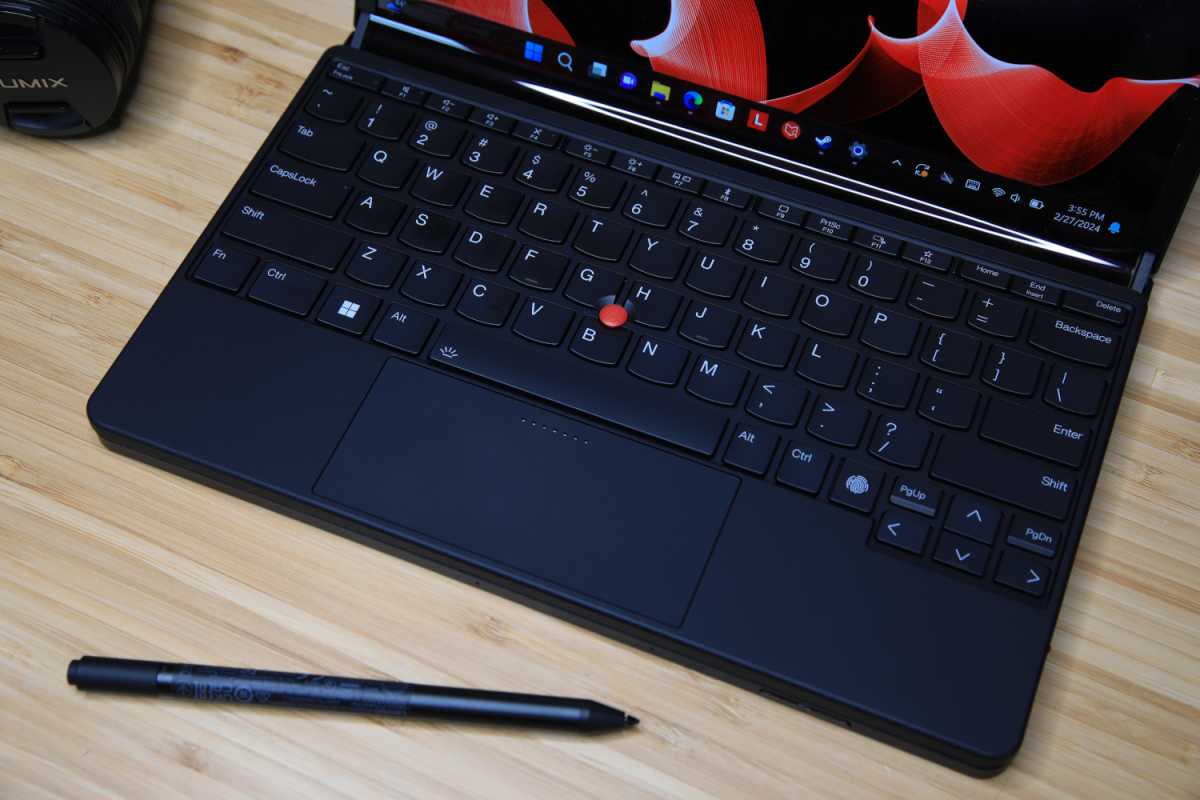
IDG / Matthew Smith
The problems continue with the keyboard. Lenovo usually scores well here, but the X1 Fold 16’s design demands compromise. The keyboard has to fit over the lower half of the X1 Fold 16’s display, so the keyboard is shallow and offers tiny palm rests. My wrists were left dangling in mid-air while the meat of my palms made contact with the edge of the keyboard. Typing felt uncomfortable after just a few minutes.
Key feel isn’t great, either. The detachable keyboard measures a little more than a quarter of an inch thick, leaving less room for each key to travel. Lenovo does what it can to provide a firm, crisp bottoming action that offers tactile and audible feedback, but I still felt the typing experience was wooden and dull.
It’s not all bad news. While the keyboard is shallow, it’s reasonably wide, and Lenovo uses every millimeter available. The result is a spacious layout where most keys are close to their full size. The keyboard is backlit, too, and of course adorned by the classic ThinkPad trackpoint, a small red nub in the center of the keyboard that can be used to control the mouse without moving your hands away from a typing position.
Lenovo also ships the device with an active pen. It’s large enough to feel comfortable in-hand and can attach magnetically to the side of the device. I wouldn’t say it felt any better or worse than other similar pens I’ve used recently, but handwriting appeared swiftly and accurately.
The touchpad, however, continues to sour the story. The keyboard’s shallow profile leaves little space, so the touchpad measures roughly four inches wide by two inches deep. That’s extremely shallow for a modern PC, and it can cause problems when using multi-touch gestures to flip between windows or scroll down a web page.
Lenovo ThinkPad X1 Fold 16: Display, audio
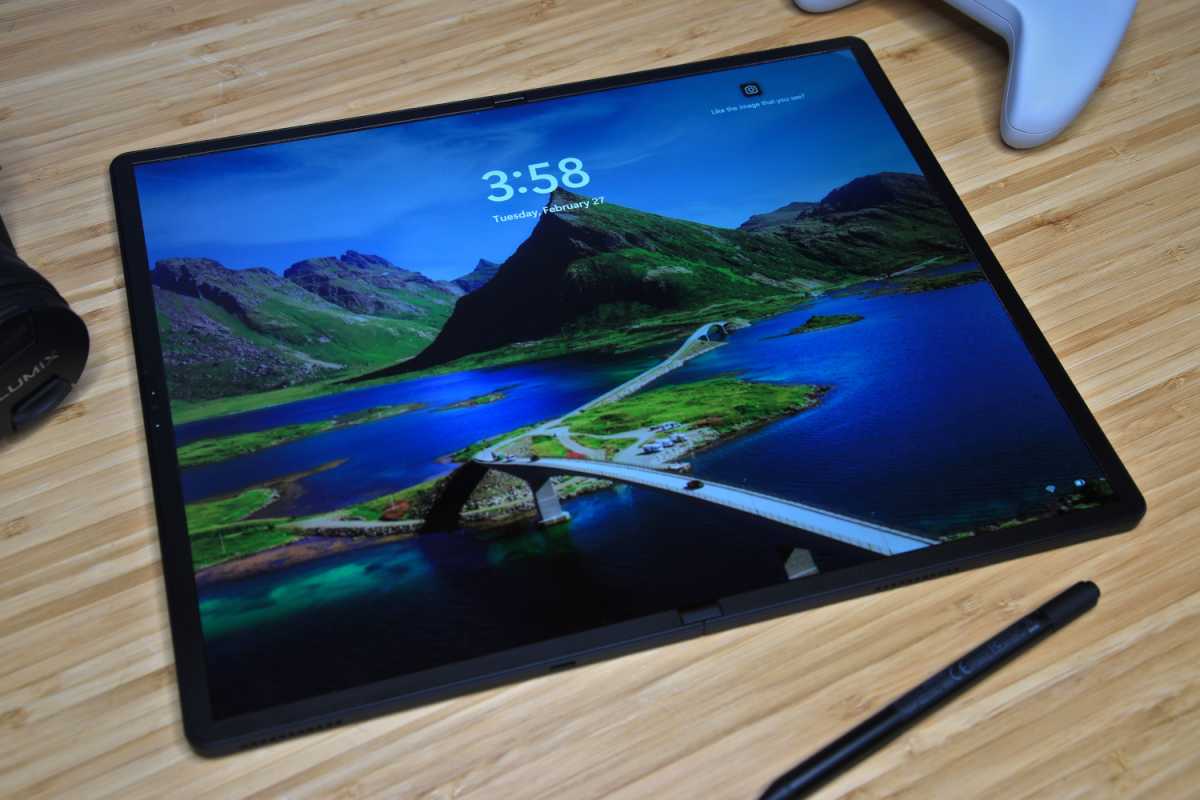
IDG / Matthew Smith
The large 16.3-inch OLED touchscreen takes a bit of the edge off the touchpad’s small size, as it’s possible to scroll or swipe on the display itself. And while the shallow keyboard is mostly a downside, it does leave the display close at hand when the X1 Fold 16 is used in clamshell mode. In fact, I found myself tapping buttons and links on the display nearly as often as the small touchpad.
It’s a beautiful display, too. The unusual 2,560 x 2,024 resolution works out to roughly 200 pixels per inch (ppi) which, though not the very best available in 2024 (the Dell XPS 16, for example, delivers over 250 ppi), is certainly more than enough to look pleasant and sharp.
OLED’s usual advantages are present, too. Color looks vibrant, the contrast ratio is high, and the display can achieve a perfect minimum luminance of zero nits when required. These perks combine for a lifelike and immersive image. I especially noticed this when using the fully unfurled 16.3-inch display with the keyboard’s kickstand. It’s a big, beautiful canvas that’s wonderful for viewing and editing photos.
However, this all comes with a caveat: display glare. Glare is a common issue for OLED displays, as most are glossy, but the X1 Fold 16 is especially reflective. Sitting in my office, with the display at half brightness, I could see my own reflection so clearly I was able to shave in an open File Explorer tab set to Dark Mode. This, as you might have guessed, is not part of my normal routine, but the X1 Fold’s extreme gloss encouraged me to give it a try. I suppose it’s a perk if you need to check your hair before a video call, but it’s more likely to prove a distraction.
The X1 Fold 16’s OLED display is paired with excellent speakers. Lenovo uses a trio of speakers, though only two are enabled depending on the mode in which the device is used. This approach prevents your hands from obstructing the speakers when holding the device. The speakers are strong, too, with good volume and a clear presentation that’s rarely muddy or dense. External speakers are better, of course, but I was happy to use the X1 Fold 16’s speakers for casual listening as I worked.
Lenovo ThinkPad X1 Fold 16: Webcam, microphone, biometrics
The X1 Fold 16’s webcam can record up to 1440p resolution at 30 frames per second. Recorded video looks crisp, attractive, and vibrant, with good color reproduction and reasonable handling of exposure in rooms with mixed lighting. It’s still a webcam, but you’ll look sharper than anyone else on your video call.
Lenovo’s microphone array captured exceedingly clear and strong audio that was easy to make out even when I spoke softly. Noise cancellation was just average, though, obscuring most repetitive noises but allowing some louder and more abrupt sounds, like a saw in a neighbor’s yard, come through. Still, it’s a good microphone and great for online chat.
There’s two forms of biometric login, as well: a fingerprint reader and facial recognition (the latter is only available with the keyboard attached). Both work well, though my usual preference for facial recognition remains, as it’s often quicker and more reliable.
Lenovo ThinkPad X1 Fold 16: Connectivity
The X1 Fold 16’s chooses to focus on the latest connectivity instead of legacy ports. It offers two Thunderbolt 4 ports, which also support USB-C, and one USB-C. All three ports support Power Delivery and can be used to charge the device. They’re also on different flanks, which means a convenient port is always available no matter how the device is used. That’s an important point not all 2-in-1s and foldable devices get right.
USB-A is missing, however, as is wired Ethernet. I don’t blame Lenovo for choosing to ditch these ports, as they don’t align with the X1 Fold 16’s futuristic design. Still, they will make legacy devices a tad harder to connect.
Wireless connectivity spans Wi-Fi 6E and Bluetooth 5.1. That’s a minor disappointment, as most laptops are moving to Wi-Fi 7. This difference is unlikely to matter for most people, as a majority of U.S. homes have yet to even upgrade to Wi-Fi 6E, nevermind Wi-Fi 7. Still, it could be an issue if you plan to hold on to the X1 Fold for many years, as Wi-Fi 6E and Wi-Fi 7 will eventually dominate.
Lenovo ThinkPad X1 Fold 16: Performance
The X1 Fold 16’s design is innovative, but the hardware inside is not. It ships with an Intel Core i7-1250U processor, 16GB of DDR5 memory, and a 512GB solid state drive. These specifications are a slight upgrade from the base model, which has an Intel Core i5-1230U. Intel’s 12th-gen core is now a couple generations behind the latest chips, and that has an impact on the X1 Fold 16’s performance.
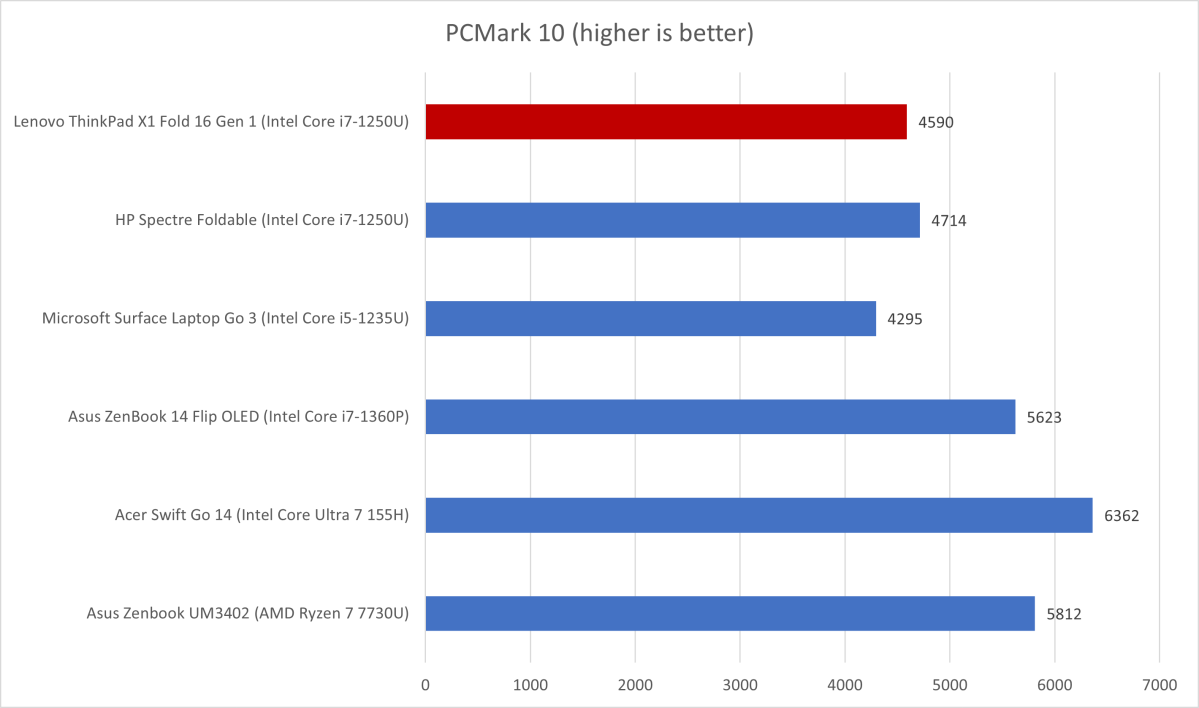
IDG / Matthew Smith
PCMark 10, which tests multiple aspects of a PC’s performance, put the X1 Fold off to a rough start with a score of 4,590. That’s towards the low end for a PC sold in 2024. Many less expensive laptops, like the Acer Swift Go 14 or HP Pavilion Plus, can outperform the X1 Fold 16.
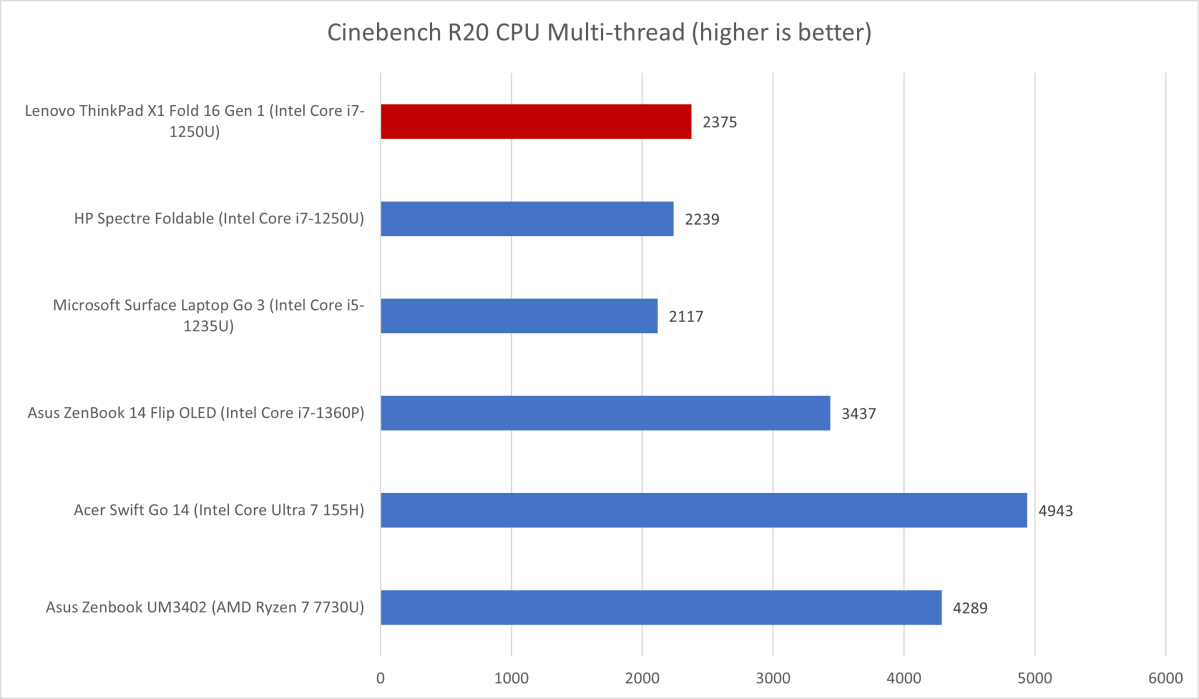
IDG / Matthew Smith
Cinebench R20, a heavily multithreaded processor benchmark, doesn’t change the narrative. The Intel Core i7-1250U has 10 cores, but only two of those are performance cores, and the processor’s maximum rated Turbo power consumption of 29 watts. The new Intel Core Ultra 7 155H, by comparison, has 16 cores with six performance cores and a maximum Turbo power consumption of 115 watts.
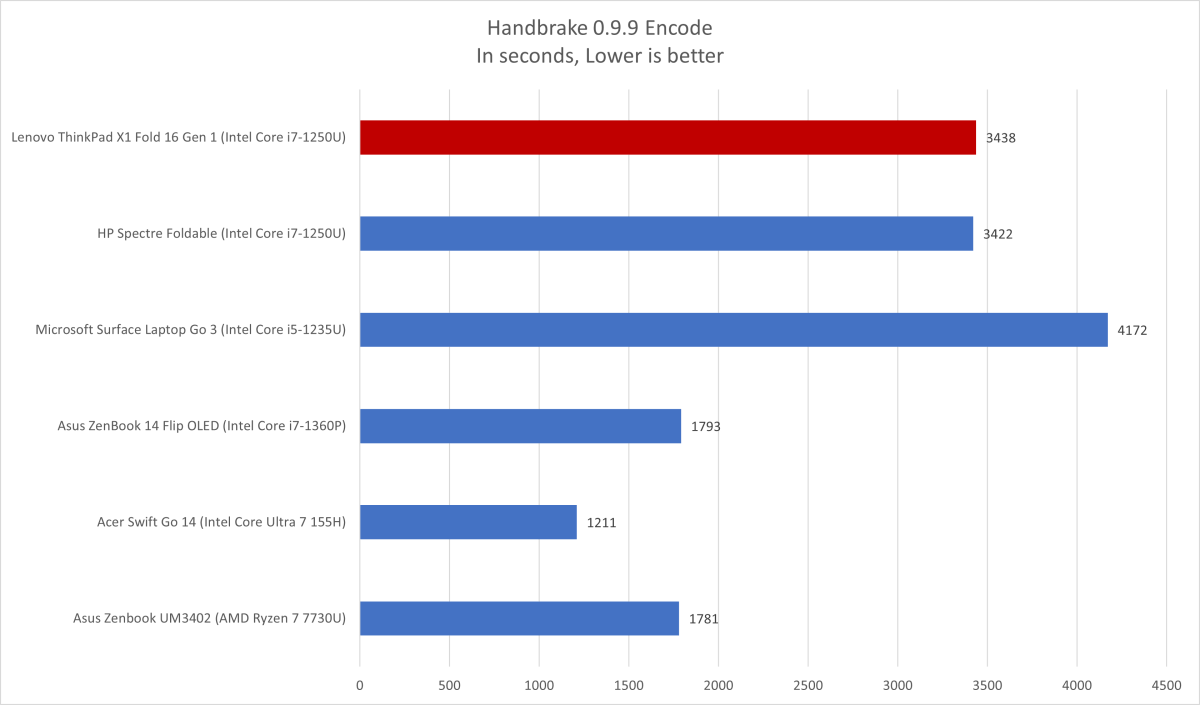
IDG / Matthew Smith
Handbrake further underscores the X1 Fold 16’s modest performance. It required nearly an hour to complete the transcode of a 1080p feature film from an .mp4 to .mkv format using Handbrake 0.9.9. Now, to be clear, it is possible to transcode more quickly using other apps and methods. What this test shows, however, is that the X1 Fold 16 isn’t a great fit for long-duration, CPU-heavy task.

IDG / Matthew Smith
The hits keep coming in 3DMark Time Spy, where the X1 Fold 16 hits a tepid score of 1,159. That’s certainly towards the low end for an Intel Core i7 processor with Iris Xe integrated graphics. Blame the maximum graphics frequency, which is rated at just 950MHz. A newer and more powerful Intel chip, like the Intel Core i7-1360P, increases that to 1.5GHz. And the latest integrated graphics from AMD and Intel can nearly triple the X1 Fold 16’s score.
In short—the X1 Fold 16 is rather awful at games and other 3D workloads. The high-resolution display doesn’t help matters, either. Even games that are many years old are unlikely to run well at the display’s native resolution.
I won’t sugarcoat it. The X1 Fold 16’s performance is bad value for money. The configuration I reviewed retails above $3,000 yet it repeatedly lost to laptops sold for as little as $1,000. This isn’t really a surprise, as the X1 Fold 16 performance is right in line with laptops we’ve tested that have similar hardware like the HP Spectre Foldable and Microsoft Surface Laptop Go 3.
There is one positive, however—the X1 Fold 16 is fanless, which means it’s completely silent. I’m not a fan of fan noise, so this benefit didn’t escape my notice. Still, as much as I value silence, it’s not enough to excuse the machine’s lackluster performance.
Lenovo ThinkPad X1 Fold 16: Battery life
The X1 Fold 16’s battery, like so much of the device, is unconventional. Lenovo ships a 48 watt-hour battery in the base model, but upgraded models pair that with a second 16 watt-hour battery, for a total of 64 watt-hours.
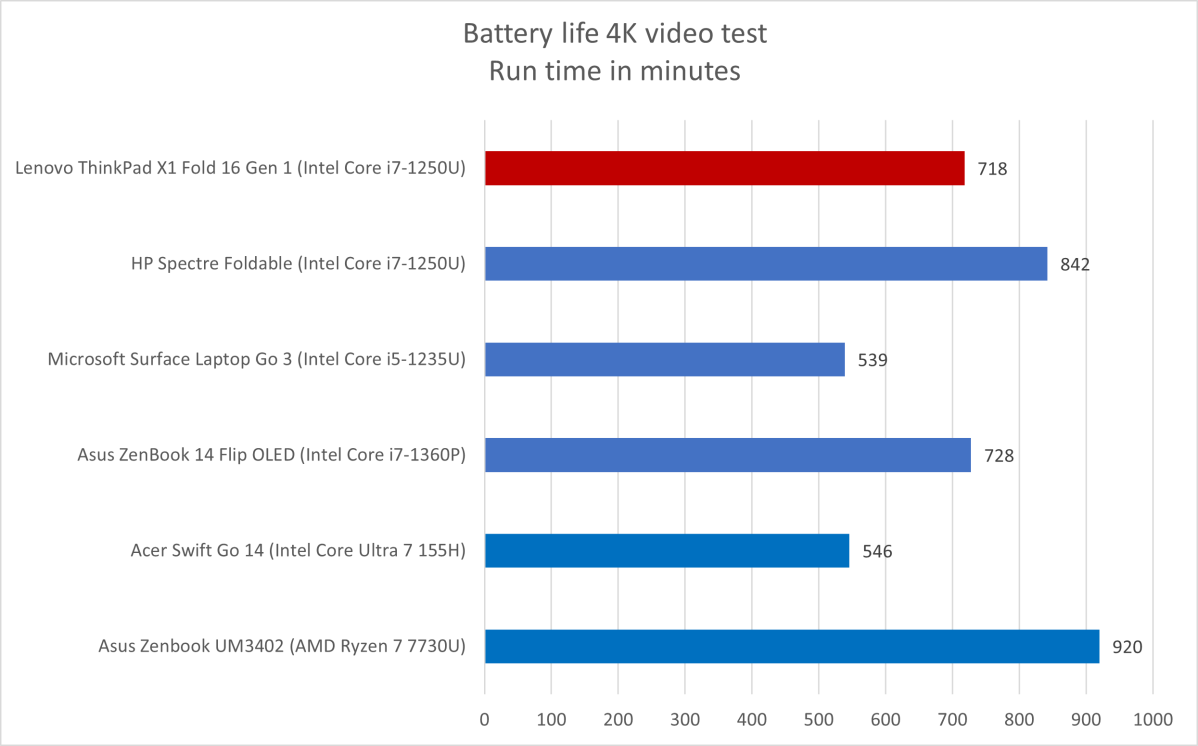
IDG / Matthew Smith
Our standard battery test, which loops a 4K file of the short film Tears of Steel, drained the X1 Fold 16’s battery in just shy of twelve hours. That’s not an exceptional result, but it’s solid and should prove up to handling a full workday even with occasional use of more demanding apps. My own day-to-day use, which mostly consists of web browsing and document editing, saw the battery last roughly 11 hours.
Lenovo ThinkPad X1 Fold 16: Conclusion
The Lenovo ThinkPad X1 Fold 16 Gen 1 is an ambitious but flawed attempt to bring a larger folder screen to a PC. It seems like a good idea on paper: the older ThinkPad X1 Fold 13 always felt too small, so a bigger screen seems to make sense.
In practice, however, the X1 Fold 16 is too bulky for use as a tablet, yet still too small and awkward to use as a laptop. It’s best when the 16-inch screen is used with the keyboard kickstand, but even this is far from perfect, as issues like the small touchpad and highly reflective screen remain a problem. And, because the X1 Fold 16 is an innovative and unusual device, Lenovo asks a tidy sum for it, making it even more difficult to recommend.
I can see a future for folding screens in PC laptops, but the X1 Fold 16 isn’t going to take them mainstream yet.
>>> Read full article>>>
Copyright for syndicated content belongs to the linked Source : PCWorld – https://www.pcworld.com/article/2250400/lenovo-thinkpad-x1-fold-16-review.html










